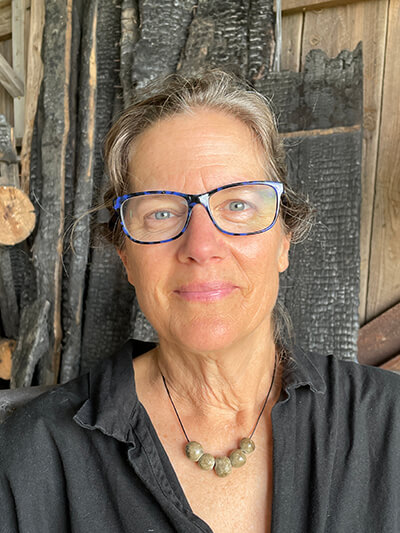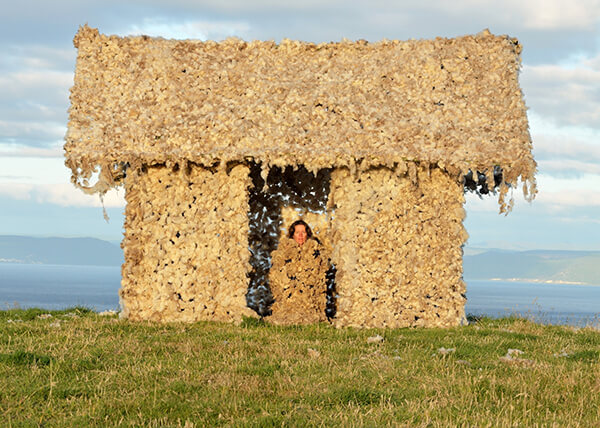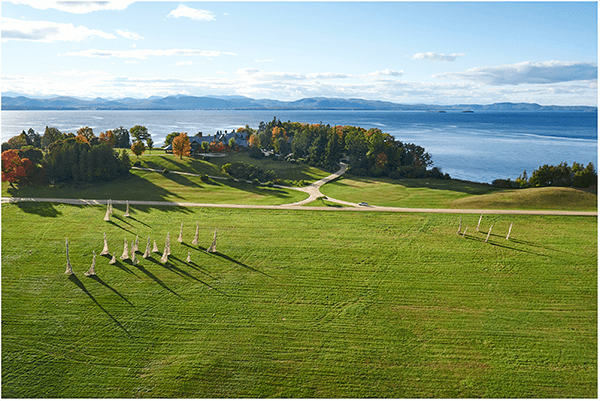Nancy Winship Milliken: Bringing her love of the environment to her art

Nancy Winship Milliken is making up for lost time. After graduating from UVM in the 1980s, she worked in the health care field. But at the age of 46 she returned to school and got her MFA at the Massachusetts College of Art and Design. “I went in as a painter and came out a sculptor,” she said. “I was more interested in still lives and using netting and wool, so tactile material started to have its own meaning. I felt that my voice was more authentic with sculpture.” While in school Milliken began creating outdoor installations using natural material.
In 2006, Milliken founded Nancy Winship Milliken Studio, which she describes as a “place-based environmental art studio committed to building community through collaborative expressions of reverence for the land, humans, and animals.” She sees a connection between her previous artwork and her current media. “When I put work in the field, I’m considering light, scale, and where the viewer should be,” she said. “It’s almost like a landscape painting.”
People often approach Milliken to offer their property for her work. She has what she describes as residencies in which she visits a farm and learns about their work and their animals. “I feel that farms are neighborhood centers that nurture our communities,” she said “so I want to shine a light on them.” In New Zealand she created her own residency after calling people to get introduced to farmers. “I did an installation where I worked with the sheep in the field using their wool,” she said.

Milliken’s artwork is made with reclaimed materials like cello bow hair, wool that wouldn’t go to the spinnery because it has too much burdock, and old barn beams. “Since we have to deal with gravity, steel is my infrastructure,” she added, noting that she tries to avoid plastics. She sometimes reuses material from artwork that has been taken down. Some installations are permanent, but many are ephemeral because the environment—in the form of the sun, wind or rain—will alter her creations. “You can almost think of the work as transitional,” she said. “The pieces allow the environment to transition them.”
Despite the fact that her work is based outdoors, Milliken often moves pieces from their initial site to a gallery or museum. “It’s taking the work and the materials out of context and placing them in a white cube,” she said. “That’s really fun and it’s a different way of looking at the work—almost highlighting it.” Often, the art only comes indoors after the environment has impacted it. “If I have things in a state of first finish,” she said “it still feels like some work needs to be done on it.”

Milliken recently received a $4,000 Creation Grant from the Vermont Arts Council to support the construction of a limestone monument of natural field elements. She has collected materials for the piece, and after they dry, she will sand them and dip them in limestone that is part of the geology around her property. Another upcoming project, slated for next summer, is a Shelburne Museum exhibition on sustainability. “My work is generated by my love of the environment and love of place,” she said.
Milliken is pleased to be able to offer a mentorship program to local students who have helped her with her projects. She noted that when she creates artwork in public, she often takes input from those watching her creative process. She has enjoyed working with a number of collaborators, including barn restorer Eliot Lothrop of Building Heritage, the farmers and animals of Bread and Butter Farm, former Vermont Poet Laureate Chard deNiord, and several architects. Although she has been involved in climate justice work, Milliken recognizes that not everyone will see those themes in her projects. She is currently working on a piece about storm water mitigation using materials from the lake, but she realizes that not everyone who sees it will understand the basis of it. “It’s more about a feeling for the land,” she said. “It’s climate awareness.”
Milliken is doing her best to make up for her late start in art. “I feel like I can’t get enough done,” she said. “It’s as if I waited all this time and now I’m just brimming.” Although her work is site-specific, Milliken believes it relates to what is happening to the environment beyond the site. “I’m so grateful to be able to do this work,” she said. “I would still be doing this even if I didn’t have exhibitions.”
